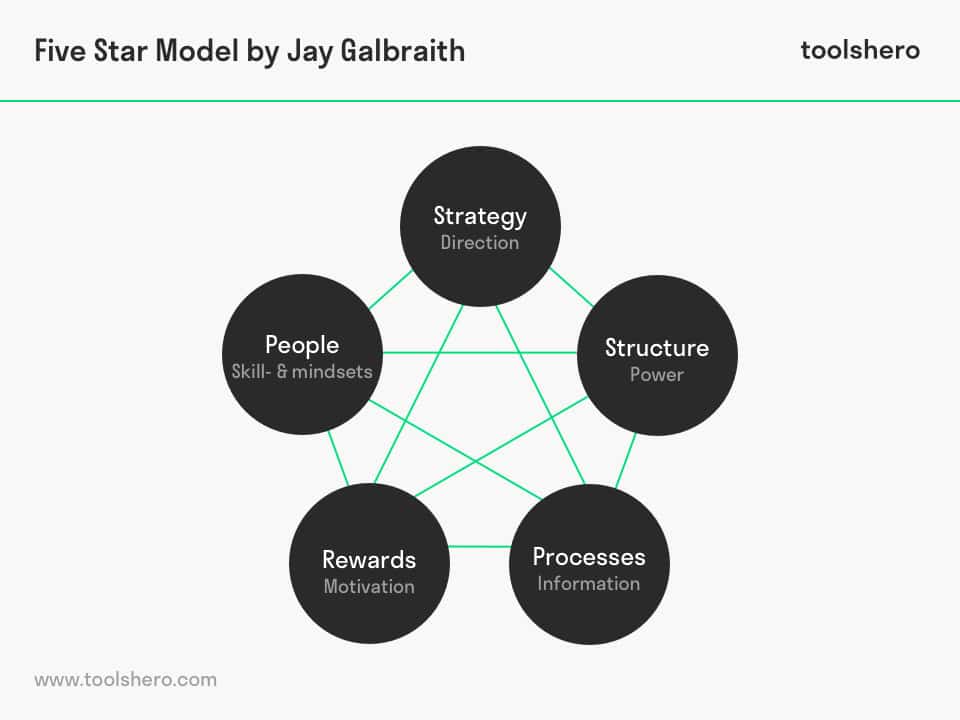Jay Galbraith’s Star Model

Galbraith Star Model: this article provides a practical explanation of the Galbraith Star Model. After reading, you’ll understand the basics of this powerful management tool.
What is Jay Galbraith’s Star Model?
Jay Galbraith’s Star Model is a framework developed by Jay Galbraith that is used in the development of organisations as a basis for design choices.
In this model, an organisation’s design is divided into five categories: strategy, structure, processes, rewards, and selection & development. These areas should be connected and outlined, in order to lay down a solid base and structure for the organisation.
By using the Galbraith Star Model to work effectively in this phase of an organisation’s development, management increases the chances of achieving good performance later on, as well as the chances of a positive corporate culture.
In the middle of the five stars, the five categories, the organisation functions as a centre of gravity holding the whole of the five areas together. Those five design components can be controlled by management and may influence employees’ behaviour.
For this reason, the design policy can be seen as a tool with which management will need to become skilled in order to effectively shape the organisation. Another effective tool for shaping organisations is the Business Model Canvas.
The Jay Galbraith’s Star Model is a well-known, frequently used design framework for organisations. The model was designed for this purpose and introduced in the 1960s.
Components of the the Galbraith Star Model
In Jay Galbraith’s Star Model, therefore, managers are able to use five levers to stimulate an effective organisation. The first lever is the strategy. The strategy is laid out by higher management and determines the organisation’s direction.
The second lever is the organisation’s structure, which determines how decision-making powers are arranged. The third category is processes. These processes relate to information flows. Rewards, when used properly, provide motivation for good behaviour. The last lever is selection and development of the right employees in the right places. This ensures the organisation will be able to work with maximum efficiency.
Strategy
The first component of Jay Galbraith’s Star Model is strategy. An organisation’s strategy is based on its mission, vision, and objectives. It determines the way in which management deals with its perspective of the future. This company formula, used to make a profit, must be adjusted regularly because of changing market circumstances.
The strategy is the means of achieving the intended goals. To put it briefly, the strategy is a long-term corporate planning and usually covers a period of around three to five years. However, a strategic vision for more than five years is not unusual either.
We distinguish between generic strategies and competitive strategies. Generic strategies include, among others, growth strategies, internationalisation, and austerity. Competitive strategies are important as well. These were all developed for a single reason: in order to be better than the competition. There are many ways in which a company may differentiate itself from its competition, including:
- Selling better products at a lower price
- Differentiate the product from the competition’s
It’s not easy, however, to reach this position in the market. Selling products at a lower price is only possible when there is a margin, or when a company is the market leader. A company may also benefit from the economy of scale principle.
Structure
The structure of an organisation determines how many departments there are and which, how many people work in them, and the number of specialised positions.
It is the second component of Jay Galbraith’s Star Model. It also dictates to the organisation how power and authority should be organised. An important part of the structure is concerned with the question of whether certain departments should be centralised or decentralised.
Processes
The third component of Jay Galbraith’s Star Model consists of the processes. When defining organisational processes, it’s important to base them on the flow of information and decisions. These flows may take place horizontally or vertically.
Horizontal processes are designed to be carried out along sideways relations between departments. These horizontal processes are also known as lateral processes. These management processes are the most important tools available to managers for managing the company. The vertical processes relate to allocating budget and talent; they deal with planning and budget processes.
Rewards
Rewards ensure that employees will internalise the company’s objectives. Rewards form the fourth component of Jay Galbraith’s Star Model. The system uses appropriate incentives to motivate employees to do the right things and help the organisation towards its objectives. The reward system should be properly implemented in all areas of the structure.
Different reward systems are appropriate for different business models. In the case of a physical store that sells exclusive products, customer satisfaction is an important factor, which means the reward system should be linked to customer safety. When it’s about a company purely aimed at sales, a performance-oriented reward system is suitable.
People
In Jay Galbraith’s Star Model, people refers to an organisation’s human resources policy. The human resources policy is concerned with recruiting and selecting new employees, training and development, promotion, and rotation.
A human resources policy should be designed to stimulate talent and to develop the capacities required to execute the management’s strategic vision.
Here, too, different business models will be able to make good use of different people. Sometimes, specific skills are required; at other times, knowledge or a certain mindset will be sought. Many companies are designed to release new products regularly.
In that case, it’s necessary that people be recruited who are proactive, reliable, and creative. In the case of a special project for a technological medical solution, on the other hand, a completely different type of person is required, for example a highly educated and skilled computer programmer or a biologist.
Jay Galbraith’s Star Model summary
Shaping an organisation is a complex process that should be carefully considered. Important principles that can be used in this process can be found in Seven Habits of Highly Effective People by Stephan Covey.
In addition, tools like Business Model Canvas and the Value Proposition Canvas may be used. When choosing the right company structure and division, the information flow should be thoroughly analysed beforehand, in order to be able to optimally arrange the infrastructure and division of power.
Finally, human resources, as well as reward systems, should be implemented. Keep factors in mind that could influence motivation, as can be read in Two Factor Theory by Frederick Herzberg.
Now it’s your turn
What do you think? Are you familiar with the explanation of Jay Galbraith’s Star Model? What do you think are the pros and cons of using this model? What else is important when it comes to designing an organisation? Do you have any tips or additional comments?
Share your experience and knowledge in the comments box below.
More information
- Galbraith, J. R. (2002). Organizing to deliver solutions. Organizational dynamics, 31(2), 194.
- Galbraith, J. R. (2008). Organization design. Handbook of organization development, 325-352.
- Galbraith, J. R. (2011). The star model. Galbraith Management Consultants, Colorado, USA.
- Kates, A., & Galbraith, J. R. (2010). Designing your organization: Using the STAR model to solve 5 critical design challenges. John Wiley & Sons.
How to cite this article:
Janse, B. (2019). Galbraith Star Model. Retrieved [insert date] from Toolshero: https://www.toolshero.com/management/jay-galbraiths-star-model/
Published on: 09/02/2019 | Last update: 03/25/2022
Add a link to this page on your website:
<a href=”https://www.toolshero.com/management/jay-galbraiths-star-model/”>Toolshero: Galbraith Star Model</a>













